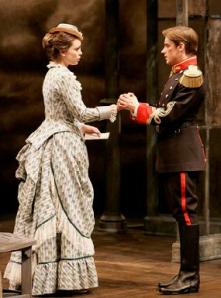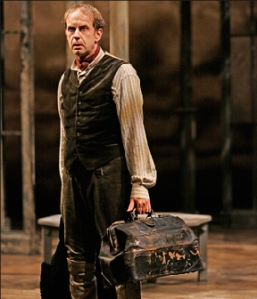By good fortune Emsworth had the opportunity to see a production of Othello last winter at the Chicago Shakespeare Theater directed by Marti Maraden. Her intelligent, text-focused approach to Shakespeare left me looking forward to more of her work in Stratford later in the year. We were not disappointed in All’s Well That End’s Well.
We would think that All’s Well presents even more challenges for a director than Othello, because the play itself has such serious internal problems that they can only be glossed over, never resolved. Moreover, while the story of Othello is familiar to many theater-goers, All’s Well That Ends Well is not well known, nor is its plot particularly memorable. With such a play, a director cannot take for granted that the audience will understand anything that is not clearly explained.
In key ways, the plot of All’s Well That Ends Well is simply unbelievable. The story begins with Bertram (Jeff Lillico), the only son of the widow Countess of Rossillion (Martha Henry), leaving home, summoned to join the court of the King of France (Brian Dennehy), who is dying. Among the tears shed at his parting are those of Helena (Daniela Vlaskalic), a pretty and accomplished young woman who has been living as the ward of the Countess since the recent death of her father, an eminent physician.
Helena cries because she has fallen hopelessly in love with Bertram — hopelessly, because Bertram has no interest in her and because their different stations in life make a match impossible in any case.
But why should she love Bertram? At the outset, we learn from Helena’s own mouth (in a soliloquy) that the attraction is physical. We are sure of that when, immediately afterward, she initiates a comic exchange with Bertram’s servant Parolles (Juan Chioran) about the merits of virginity.
But as the play unfolds, Bertram shows himself to be contemptible and unmanly. Pressured by the king to marry Helena (who has healed the king with a prescription inherited from her father), Bertram insults Helena and then pretends to give in to the King’s wishes while making secret plans to escape the marriage. Later in the play, having fled to Italy as a soldier to avoid sleeping with his bride (!), he tries to seduce Diana (Leah Oster) a respectable young virgin of Florence, then, to save his own skin, defames her as a whore.
Bertram is thoroughly detestable — but Helena persists in wanting him for a husband. After living in the same household with them, how could she have failed to see his character? And once his behavior becomes known all over Europe, how could she still want him? There is no explanation for Helena’s steadfastness in pursuit of Bertram.
Equally hard to believe is that everyone in the play except Bertram seems to know that his foppish friend and follower Parolles is a braggart and a coward. Bertram may be a cad, but he hardly seems a fool. Why does it take an elaborate practical joke on Parolles to convince Bertram that he has an unworthy friend?
Yet Marti Maraden’s perfectly-paced production of All’s Well That Ends Well holds together beautifully despite the play’s improbabilities. Wherever the Bard touches on one of his themes throughout the play, Maraden helps us draw the dots. For example, Helena and Parolles introduce the themes of virginity and procreation early in the play; the clown Lavache (Tom Rooney) develops them in strangely profound comic speeches; and Diana brings them full circle in a late scene.
Most of all, this is a play about our universal experience of grief, loss, and resignation, climaxed by the Countess’s lament:
My heart is heavy, and mine age is weak;
Grief would have tears, and sorrow bids me speak.
(Act III, Scene 5). It would be easy for a director to waste energy trying to make too much of the weak storyline, at the expense of the play’s poetry. Not so here.
We loved the hilarious (and almost cruel) scene in which the blindfolded Parolles is unmasked as a liar and a fraud. But this show has a number of outstanding performances. The tireless Ben Carlson (who played an energetic Hamlet later the same day that we saw All’s Well That Ends Well) brings the most out of his supporting role as the First Lord Dumaine. Fiona Reid, as the Widow Capilet, and Michelle Fisk, as Mariana, are both delightful.
It goes without saying that the lovely and gracious Martha Henry, the veteran Stratford actress, is perfectly cast as the Countess of Rossillion. What I will remember most about this show, however, is the wonderful, tender performance of Tom Rooney as the comic philosopher Lavache.
Unfortunately, there are weak performances as well. The most disappointing is that of Daniela Vlaskalic as Helena. She declaims her lines in an unnatural, almost sing-song manner, having failed to learn from Martha Henry how to project her voice in a large theater without sacrificing expression and meaning. The most jarring performance is that of Leah Oster, who inexplicably brings to All’s Well That Ends Well the same midwestern drawl that she apparently uses as Marian the Librarian in The Music Man, also part of the Stratford Festival’s 2008 season. And I could not help feeling that Brian Dennehy, as the King of France, was saving his energy for something else.
According to the program notes, this production of All’s Well That Ends Well (probably written around 1602) is set in 1889 (the opening scene is set in a railroad station). As is usual with the deplorable practice of setting Shakespeare plays in different time periods, this led to distracting incongruities.
I was able to overlook the historical fact that, in 1889, it had been a hundred years since there had been a French king. But I had more difficulty with Helena and her “holy pilgrimage.” According to Shakespeare’s text (Act III, Scene 5), Helena has come to Florence in disguise, pretending to be a pilgrim to a saint’s shrine. (Her real purpose in Florence is to pursue her husband and obtain her marital rights).
Students of European social history can correct me, but it is my sense that the practice of undertaking long pilgrimages on foot to religious shrines died out long before 1889. And if Ms. Vlaskalic as Helena was supposed to be wearing a “pilgrim” disguise in these scenes, I could not make it out. Once again, the “modern” setting served only to muddle the plot.
Emsworth reviews the Stratford Festival’s 2008 production of Hamlet in this post.
Emsworth gripes about the recent leadership debacle at the Stratford Festival, which resulted last winter in Des McAnuff’s becoming the sole artistic director of the Festival, in this post.
Other Emsworth posts include reviews of shows in the Shaw Festival’s 2008 season, including Bernard Shaw’s Getting Married (see this post), Lillian Hellman’s The Little Foxes (see this post), Leonard Bernstein’s musical Wonderful Town (see this post), and J. B. Priestley’s The Inspector Calls (see this post).



